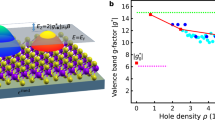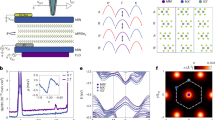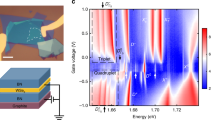Abstract
Spin–valley locking is ubiquitous among transition metal dichalcogenides with local or global inversion asymmetry, in turn stabilizing properties such as Ising superconductivity, and opening routes towards ‘valleytronics’. The underlying valley–spin splitting is set by spin–orbit coupling but can be tuned via the application of external magnetic fields or through proximity coupling. However, only modest changes have been realized to date. Here, we investigate the electronic structure of the V-intercalated transition metal dichalcogenide V1/3NbS2 using microscopic-area spatially resolved and angle-resolved photoemission spectroscopy. Our measurements and corresponding density functional theory calculations reveal that the bulk magnetic order induces a giant valley-selective Ising coupling exceeding 50 meV in the surface NbS2 layer, equivalent to application of a ~250 T magnetic field. This energy scale is of comparable magnitude to the intrinsic spin–orbit splittings, and indicates how coupling of local magnetic moments to itinerant states of a transition metal dichalcogenide monolayer provides a powerful route to controlling their valley–spin splittings.
This is a preview of subscription content, access via your institution
Access options
Access Nature and 54 other Nature Portfolio journals
Get Nature+, our best-value online-access subscription
$29.99 / 30 days
cancel any time
Subscribe to this journal
Receive 12 print issues and online access
$259.00 per year
only $21.58 per issue
Buy this article
- Purchase on Springer Link
- Instant access to full article PDF
Prices may be subject to local taxes which are calculated during checkout




Similar content being viewed by others
Data availability
The research data supporting this publication can be accessed at the University of St Andrews Research Portal: https://doi.org/10.17630/fb5496ed-6eae-49fa-9214-cd3507265f2b (ref. 40).
Code availability
The codes used in this study are available either publicly (Wannier90; http://www.wannier.org) or through subscription (Vienna Ab-initio Simulation Package; https://www.vasp.at). For a detailed description of input parameters used for each code, refer to the ‘Calculations’ section in the Methods. Further inquiries should be addressed to the corresponding authors.
References
Guillamón, I. et al. Superconducting density of states and vortex cores of 2H-NbS2. Phys. Rev. Lett. 101, 166407 (2008).
Heil, C. et al. Origin of superconductivity and latent charge density wave in NbS2. Phys. Rev. Lett. 119, 087003 (2017).
van Loon, E. G. C. P., Rösner, M., Schönhoff, G., Katsnelson, M. I. & Wehling, T. O. Competing Coulomb and electron–phonon interactions in NbS2. npj Quantum Mater. 3, 32 (2018).
Parkin, S. S. P. & Friend, R. H. 3d transition-metal intercalates of the niobium and tantalum dichalcogenides. II. Transport properties. Philos. Mag. B 41, 95–112 (1980).
Kousaka, Y. et al. Chiral helimagnetism in T1/3NbS2 (T=Cr and Mn). Nucl. Instrum. Methods Phys. Res. A 600, 250–253 (2009).
Togawa, Y. et al. Chiral magnetic soliton lattice on a chiral helimagnet. Phys. Rev. Lett. 108, 107202 (2012).
Nair, N. L. et al. Electrical switching in a magnetically intercalated transition metal dichalcogenide. Nat. Mater. 19, 153–157 (2020).
Little, A. et al. Three-state nematicity in the triangular lattice antiferromagnet Fe1/3NbS2. Nat. Mater. 19, 1062–1067 (2020).
Hall, A. E. et al. Magnetic structure investigation of the intercalated transition metal dichalcogenide V1/3NbS2. Phys. Rev. B 103, 174431 (2021).
Lu, K. et al. Canted antiferromagnetic order in the monoaxial chiral magnets V1/3TaS2 and V1/3NbS2. Phys. Rev. Mater. 4, 054416 (2020).
Battaglia, C. et al. Non-uniform doping across the Fermi surface of NbS2 intercalates. Eur. Phys. J. B 57, 385–390 (2007).
Sirica, N. et al. Electronic structure of the chiral helimagnet and 3d-intercalated transition metal dichalcogenide Cr1/3NbS2. Phys. Rev. B 94, 075141 (2016).
Tanaka, H. et al. Large anomalous Hall effect induced by weak ferromagnetism in the noncentrosymmetric antiferromagnet CoNb3S6. Phys. Rev. B 105, L121102 (2022).
Nakagawa, N., Hwang, H. Y. & Muller, D. A. Why some interfaces cannot be sharp. Nat. Mater. 5, 204–209 (2006).
Hossain, M. A. et al. In situ doping control of the surface of high-temperature superconductors. Nat. Phys. 4, 527–531 (2008).
Sunko, V. et al. Maximal Rashba-like spin splitting via kinetic-energy-coupled inversion-symmetry breaking. Nature 549, 492–496 (2017).
Mazzola, F. et al. Itinerant ferromagnetism of the Pd-terminated polar surface of PdCoO2. Proc. Natl Acad. Sci. USA 115, 12956–12960 (2018).
Seah, M. P. & Dench, W. A. Quantitative electron spectroscopy of surfaces: a standard data base for electron inelastic mean free paths in solids. Surf. Interface Anal. 1, 2–11 (1979).
Xiao, D., Liu, G.-B., Feng, W., Xu, X. & Yao, W. Coupled spin and valley physics in monolayers of MoS2 and other group-VI dichalcogenides. Phys. Rev. Lett. 108, 196802 (2012).
Mak, K. F., He, K., Shan, J. & Heinz, T. F. Control of valley polarization in monolayer MoS2 by optical helicity. Nat. Nanotechnol. 7, 494–498 (2012).
Zeng, H., Dai, J., Yao, W., Xiao, D. & Cui, X. Valley polarization in MoS2 monolayers by optical pumping. Nat. Nanotechnol. 7, 490–493 (2012).
Riley, J. M. et al. Direct observation of spin-polarized bulk bands in an inversion-symmetric semiconductor. Nat. Phys. 10, 835–839 (2014).
Bawden, L. et al. Spin-valley locking in the normal state of a transition-metal dichalcogenide superconductor. Nat. Commun. 7, 11711 (2016).
Xu, X., Yao, W., Xiao, D. & Heinz, T. F. Spin and pseudospins in layered transition metal dichalcogenides. Nat. Phys. 10, 343–350 (2014).
Sirica, N. et al. The nature of ferromagnetism in the chiral helimagnet Cr1/3NbS2. Commun. Phys. 3, 65 (2020).
Popčević, P. et al. Role of intercalated cobalt in the electronic structure of Co1/3NbS2. Phys. Rev. B 105, 155114 (2022).
Yosida, K. Magnetic properties of Cu-Mn alloys. Phys. Rev. 106, 893–898 (1957).
Geldenhuys, J. & Wiid, D. H. RKKY interaction and conduction electron polarisation. J. Phys. F Met. Phys. 8, 2021–2033 (1978).
Srivastava, A. et al. Valley Zeeman effect in elementary optical excitations of monolayer WSe2. Nat. Phys. 11, 141–147 (2015).
Aivazian, G. et al. Magnetic control of valley pseudospin in monolayer WSe2. Nat. Phys. 11, 148–152 (2015).
Li, Y. et al. Valley splitting and polarization by the Zeeman effect in monolayer MoSe2. Phys. Rev. Lett. 113, 266804 (2014).
MacNeill, D. et al. Breaking of valley degeneracy by magnetic field in monolayer MoSe2. Phys. Rev. Lett. 114, 037401 (2015).
Zhong, D. et al. Van der Waals engineering of ferromagnetic semiconductor heterostructures for spin and valleytronics. Sci. Adv. 3, e1603113 (2017).
Zhong, D. et al. Layer-resolved magnetic proximity effect in van der Waals heterostructures. Nat. Nanotechnol. 15, 187–191 (2020).
Norden, T. et al. Giant valley splitting in monolayer WS2 by magnetic proximity effect. Nat. Commun. 10, 4163 (2019).
Perdew, J. P., Burke, K. & Ernzerhof, M. Generalized gradient approximation made simple. Phys. Rev. Lett. 77, 3865–3868 (1996).
Kresse, G. & Furthmüller, J. Efficient iterative schemes for ab initio total-energy calculations using a plane-wave basis set. Phys. Rev. B 54, 11169–11186 (1996).
Kresse, G. & Joubert, D. From ultrasoft pseudopotentials to the projector augmented-wave method. Phys. Rev. B 59, 1758–1775 (1999).
Mostofi, A. A. et al. wannier90: a tool for obtaining maximally-localised Wannier functions. Comput. Phys. Commun. 178, 685–699 (2008).
Edwards, B. et al. Giant valley–Zeeman coupling in the surface layer of an intercalated transition metal dichalcogenide (University of St Andrews Research Portal); https://doi.org/10.17630/fb5496ed-6eae-49fa-9214-cd3507265f2b
Acknowledgements
We thank M. Leandersson and T. Balasubramanian for useful discussions. We gratefully acknowledge support from the Leverhulme Trust (grant no. RL-2016-006; P.D.C.K., B.E., T.A., A.R. and C.B.), the European Research Council (through the QUESTDO project, 714193; P.D.C.K. and G.-R.S.), the Engineering and Physical Sciences Research Council (grant nos EP/T02108X/1 (P.D.C.K. and P.A.E.M.) and EP/N032128/1 (D.A.M. and G.B.)) and the Center for Computational Materials Science at the Institute for Materials Research for allocations on the MASAMUNE-IMR supercomputer system (project no. 202112-SCKXX-0510; R.V.B. and M.S.B.). S.B., E.A.M. and A.Z. gratefully acknowledge studentship support from the International Max-Planck Research School for Chemistry and Physics of Quantum Materials. We gratefully acknowledge the MAX IV Laboratory for time on the Bloch beamline under proposal nos 20200227, 20210091 and 20210763. Research conducted at MAX IV, a Swedish national user facility, is supported by the Swedish Research council under contract 2018-07152, the Swedish Governmental Agency for Innovation Systems under contract 2018-04969 and Formas under contract 2019-02496. The research leading to this result has been supported by the project CALIPSOplus under grant agreement 730872 from the EU Framework Programme for Research and Innovation HORIZON 2020. For the purpose of open access, we have applied a Creative Commons Attribution (CC BY) licence to any Author Accepted Manuscript version arising.
Author information
Authors and Affiliations
Contributions
The ARPES data were measured by B.E., P.A.E.M., S.B., T.A., G.-R.S., A.R., E.A.M., A.Z., C.B. and P.D.C.K. and analysed by B.E.; O.D., R.V.B. and M.S.B. performed the DFT and tight-binding calculations. A.E.H., D.A.M. and G.B. grew and characterized the samples. C.M.P. and D.C. maintained the Bloch beamline and provided experimental support. B.E., O.D., M.S.B. and P.D.C.K. wrote the manuscript with input and contributions from all authors.
Corresponding authors
Ethics declarations
Competing interests
The authors declare no competing interests.
Peer review
Peer review information
Nature Materials thanks the anonymous reviewers for their contribution to the peer review of this work.
Additional information
Publisher’s note Springer Nature remains neutral with regard to jurisdictional claims in published maps and institutional affiliations.
Supplementary information
Supplementary Information
Supplementary Figs. 1–15 and Discussion.
Rights and permissions
Springer Nature or its licensor (e.g. a society or other partner) holds exclusive rights to this article under a publishing agreement with the author(s) or other rightsholder(s); author self-archiving of the accepted manuscript version of this article is solely governed by the terms of such publishing agreement and applicable law.
About this article
Cite this article
Edwards, B., Dowinton, O., Hall, A.E. et al. Giant valley-Zeeman coupling in the surface layer of an intercalated transition metal dichalcogenide. Nat. Mater. 22, 459–465 (2023). https://doi.org/10.1038/s41563-022-01459-z
Received:
Accepted:
Published:
Issue Date:
DOI: https://doi.org/10.1038/s41563-022-01459-z
This article is cited by
-
A magnetic field for each electron
Nature Materials (2023)
-
Spin-orbit coupled spin-polarised hole gas at the CrSe2-terminated surface of AgCrSe2
npj Quantum Materials (2023)



